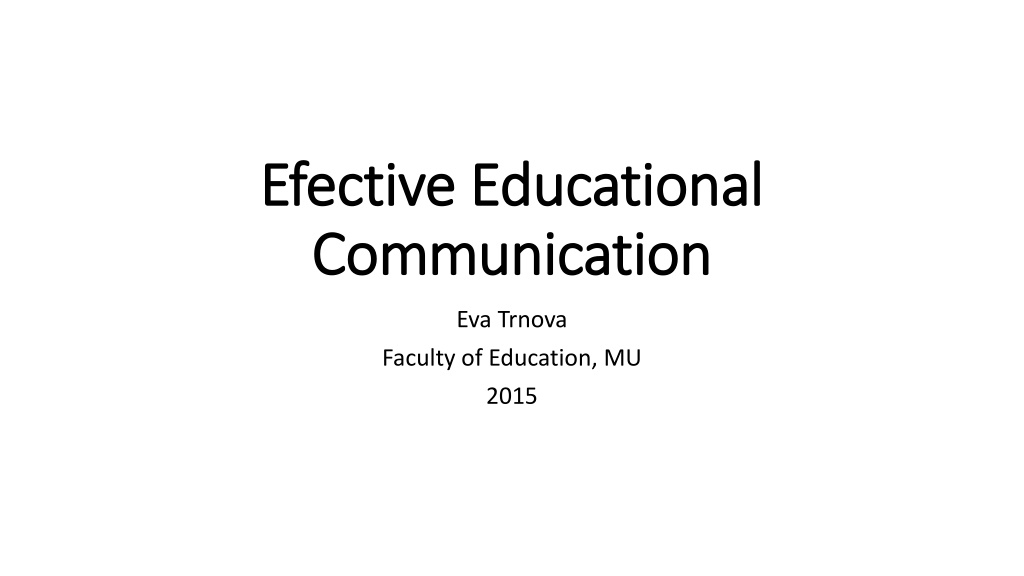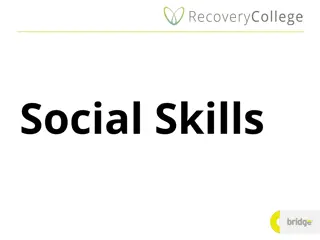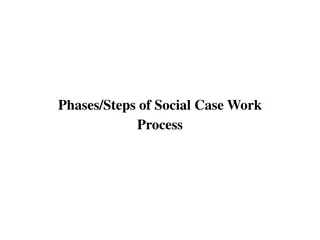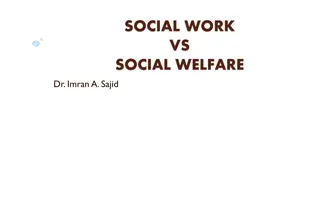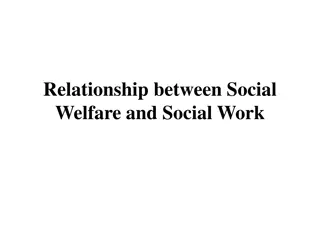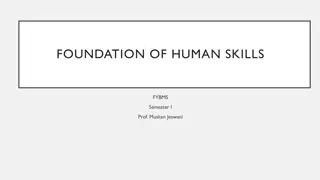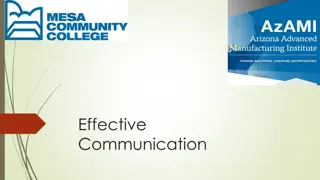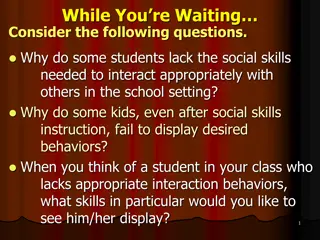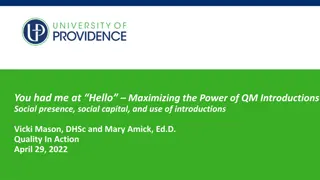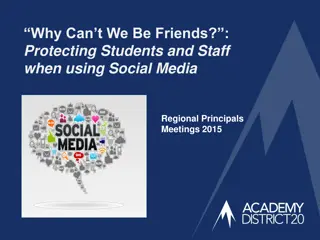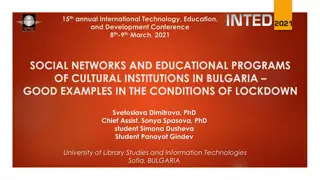Understanding the Differences Between Educational Communication and Social Communication
Educational communication focuses on conveying specific meanings within social behavior in the educational context, involving teachers, students, and parents. It is situation-specific and utilizes verbal, non-verbal, and action-based communication tools. Social communication shares similar content with educational communication but differs in context and goals, emphasizing mutual exchange of information in various social situations.
Download Presentation

Please find below an Image/Link to download the presentation.
The content on the website is provided AS IS for your information and personal use only. It may not be sold, licensed, or shared on other websites without obtaining consent from the author. Download presentation by click this link. If you encounter any issues during the download, it is possible that the publisher has removed the file from their server.
E N D
Presentation Transcript
Efective Efective Educational Educational Communication Communication Eva Trnova Faculty of Education, MU 2015
Educational Communication Educational communication is a specific form of social communication. The point of educational communication is to communicate and supply certain meanings in social behaviour within the scope of interpersonal relations. Social interaction incorporates three main aspects: (1) interaction viewpoint (mutual impact, influence); (2)communication viewpoint (the supply of meanings); (3) perceptional viewpoint (perception of our partners in the scope of linear....???
What are the differences between Educational Communication and Social Communication? Takes place between the participants of the educational process.(teachers, students, headmaster, parents) Is always connected to a certain situation in the educational process (For example, a discussion about ways of growing carnations between two teachers during the break, would not be regarded as Educational Communication)
What are the differences between Educational Communication and Social Communication? Teacher's profession is associated with the skill of effective communication, which can be learnt, exercised, developed, and improved. Educational Communication employs different tools of Social Communication: (1) Verbal Form, communication by means of a word (spoken, written); (2) Non-verbal, tj. communication without the use of a word; (3) Communication by a deed, a certain action takes place
What are the differences between Educational Communication and Social Communication? For Social and Educational Communication even the content is identical. We communicate: (a) The Information (b) Our Emotion (c) Our attitude towards the content of our conversation (d) Our attitude towards the person we are speaking to (e) The rules of communication (f) The acceptance of our self-concept Communication is characteristic with its intentions and goals. Moreover, it serves the goals that it incorporates.
What are the differences between Educational Communication and Social Communication? Communication is characteristic with its intentions and goals. Moreover, it serves the goals that it incorporates. It is usually defined as mutual exchange of information between the participants of the educational process. It is a device used in upbringing and education
What are the differences between Educational Communication and Social Communication? Educational Communication can be viewed from two perspectives: the content and the process. The information mediated to the students have generally three components: (a) cognitive component influences the development of recognition of student's character; (b) affected component influences development of learning motivation, strengthens ability of making opinions; (c) regulative component it helps the implementation of schooling. Those three components do occur integrated in practice they form the content surface of Educational Communication in teaching.
The tools of Educational Communication: Verbal Communication Speech - is the most frequently used device of interpersonal communication. There are three speech organs that take part in speech production: Breathing Organs, Organs producing Voice, and Articulation. Breath teacher must adopt a so called 'Breath Economy', which is an economical and conscious control of breathing to facilitate better speech performance. Voice each voice has three qualities: strength, pitch, and color. These qualities compromise the acoustic attributes of the voice. Teacher must master another important characteristic: flexibility (dynamics, tone) and the persistence of his or hers voice.
Nine characteristics of the Voice (paralinguistic aspects of speech) (1) The Intensity of the Voice ( the change of the volume, dynamics); (2) The Tone Pitch of the Voice; (3) The Colour of the Voice; (4) The length of the Speech; (5) The Rate of the Speech; (6) The Breaks and Pauses made during he Speech; (7) The Acoustic Content of the Breaks (Silence or Humming); (8) The Accuracy of the Speech (Avoidance of 'Slips of the Tongue', Mistakes, and Parasitic Words); (9) The Manner of Word Delivery.
??? The content of verbal communication should be matter-of-fact, accurate, comprehensible, brief, linguistically correct, and adequate for the specific group of students. Rules and principles to be followed while talking to a student: (1) To empathize with the student. (2) To respect the personality of the student. (3) To hold an authentic, genuine attitude. (4) To be specific. The negative aspect of this communication is the difficulty of sharing emotions, showing attitudes towards other people or subjects, etc
Non-verbal Communication Talking without words' is a kinetic behaviour, whose expressional tools are for example: gestures, facial expressions, body postures and others. These are mutually interconnected into meaningful unintentional or intentional messages. Thanks to this communication it is easier to share emotions, attitudes towards the student, class or subject. Very young learners are not capable of accurate verbal communication like adults. Therefore, they are more sensitive to non- verbal information signals.
Types of non-verbal communication (1) 'Giving a Look' communication - it's the most frequent non-verbal means of communication. In reality the teacher observes a student or the whole class. On the other hand, the student will pay attention to a teacher who is sympathetic, gives praises and motivates. In every social (and educational) interaction are eyes functioning as a sensitive receptor, receiver and transmitter of information. Additionally, by means of their social function eyes give evidence of the personality of other human being, their psychological state, attributes, and relationship towards us. The teacher should observe the focus of the students look and its duration, frequency, sequence, extent and direction, shape and movement of the eyes including blinking, and last but not least the skin around the eyes. The teacher should not only be able to read from the students looks, but also be fair in dividing his or hers looks at each student.
Types of non-verbal communication (2) Communication via 'the looks on one's face' (facial expressions) - it is mostly based on the manifestation of emotions. Therefore, teacher can distinguish student's emotions of fear, sadness, happiness or surprise. Every teacher should be able to recognize if the student is anxiety, surprise, or happiness. Additionally, the teacher should be able to distinguish if the emotions are authentic or pretended. Unfortunately, teachers frequently misdiagnose students' unintentional face expressions as eye-rolling, frowning, grimace, or even pouting.
Types of non-verbal communication (3) Communication via 'movements' (kinetics) - are the movements that are signalizing even the smallest trembles of one's inner mental state. We distinguish two types of students: (a) One group is fully capable of expressing itself and vividly gesticulates. But when knowledge of subject is missing, students are weakening even in movements. (b) Second group consists of individuals that have difficulty expressing themselves. The worse their vocal discourse gets, the more lively their movements become. The teacher should be able to distinguish by students' movements his or hers psychological state; two malfunctions are recognized: coordination and synchronization. For example, motion restlessness like shuffling around, swaying, arm and head jerking, squirming, etc. signalize anxiety, fear, tension and other manifestation connected with things like decreased ability of concentration, various blocks of the thought process, memory loss, etc.
Types of non-verbal communication (4) Communication via 'body postures' (post-urology) - it is a function linked to the body posture and configuration of each part of the body. Position, in which the student is, actually expresses the overall attitude. In most cases, the student strikes a pose that is a part of an act that the student puts on to show his or hers unfriendly attitude towards the teacher. At the same time, this pose is a cover up for students feeling of uncertainty and stage fright.
Types of non-verbal communication (5) Communication via 'gestures'. Gestures (e.g. the movements of hands and other parts of the body - head turning, bow) have a communicative function - these are movements which accompany verbal communication or they even replace them. The teacher should always strive for self-control and self-knowledge while using gestures.
Types of non-verbal communication (6) Communication via 'touch' (tactile contact, haptics) - e.g. a handshake, a squeeze, a hug, a stroke, a kiss, a pat, a pinch, a poke, etc. Touch, when considered from educational communication's point of view can be taken as a token of hostility (a slap, a smack in the face, a push etc.) or a sign of friendship (a stroke, a pat). There also a symbolic manifestations, such as when teacher instead of verbal reprimanding taps lightly on students arm. The teacher should touch the students very carefully and with optimal degree.
Types of non-verbal communication (7) Communication via 'use of space' - approximation or pulling away from each other (proxemics) - mutual interpersonal relations between people in a certain group. In a particular space we tend to move closer to people that are sympathetic, and move away from people that are unpleasant. While in class, the teacher is associating in the public, social, and personal sphere; exceptionally in the intimate sphere. The area (of the front desk) in the class is more frequent in interaction and is marked as so called 'action zone'. The teacher usually communicates more often with students in this area and they are also more active. Additionally, an' eye-to eye' communication is very suitable - feelings of dominance or inferiority.
Types of non-verbal communication (8) Communication via 'appearance' - stresses the importance of one's appearance and style of clothes, hair and make-up, etc. The appearance of the teacher provides certain information about the teacher's character traits and the teacher is therefore under the students' scrutiny. Another important factor is arrangement of the class and its environment. Information about the student can be distinguished from student's desk and how tidy or messy his things are, etc. Same applies to teacher's desk.
Communication vis 'deed' Meaning the interaction between the teacher and students, how they treat each other and what attitude they have towards each other. The students definitely do sense how well is the teacher prepared and ready for the class. They evaluate if he or she arrives on time, gives fair marks and the overall attitude towards them. With the behavior and each deed, the teacher shows the class and each student his or her appreciation and respect social evaluation (increase in value) or the other way around social devaluation. Factors influencing teacher attitude towards the student: (a) social role of the teacher (the class teacher is usually more objective and helpful); (b) teacher conception of a good student ; (c) qualities and appearance of the student; (d) if the student is talkative; (e) class, which the student visits.
The style of upbringing With communication definitely goes hand in hand the choice of style of upbringing. It is important to recognize who in the class is the authority that sets all norms and makes sure that they are being kept. (a) Authoritative (autocratic) style where the teacher sets the norms and makes sure that they are kept. (b) Democraic style the teacher sets the norms with the cooperation of the students, and teacher makes sure that they are kept. (c) Liberal style the teacher sets the norms with the cooperation of the students, and the students are responsible themselves for keeping them. The choice of style always depends on individual class and situation, and is closely interconnected with the authority of the teacher.
The style of upbringing To be able to communicate properly, the teacher must be able to communicate effectively. Meaning that the teacher must know how to express points properly, must be a good listener, and be empathetic = empathy. Principles of simplifying communication: (1) Communication while during lessons should be purposeful. (2) We should communicate only with attentive listeners. (3) We should allow the possibility of misunderstanding with the students. (4) The communication should always incorporate humour. (5) In any case there should be humiliation or ridicule present in communication with students.
Key words educational communication, verbal communication, non-verbal communication, communication via deed
